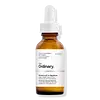What's inside
What's inside
 Key Ingredients
Key Ingredients

 Benefits
Benefits

 Concerns
Concerns

 Ingredients Side-by-side
Ingredients Side-by-side

Water
Skin ConditioningDiglycerin
HumectantTrideceth-9
EmulsifyingEthylhexyl Methoxycrylene
Skin ConditioningPEG-40 Hydrogenated Castor Oil
EmulsifyingPanthenol
Skin ConditioningRetinol
Skin ConditioningAscorbyl Tetraisopalmitate
AntioxidantAscorbyl Palmitate
AntioxidantTocopherol
AntioxidantAllantoin
Skin ConditioningCholesterol
EmollientSphingolipids
EmollientPhospholipids
Skin ConditioningLecithin
EmollientHydrogenated Palm Glycerides Citrate
EmollientPolyacrylate Crosspolymer-6
Emulsion StabilisingPolysorbate 20
EmulsifyingEthylhexylglycerin
Skin ConditioningT-Butyl Alcohol
PerfumingGlyceryl Stearate
EmollientPotassium Sorbate
PreservativeGlyceryl Oleate
EmollientSodium Citrate
BufferingCitric Acid
BufferingBHT
AntioxidantBHA
AntioxidantPhenoxyethanol
PreservativeDisodium EDTA
Sodium Hydroxide
BufferingWater, Diglycerin, Trideceth-9, Ethylhexyl Methoxycrylene, PEG-40 Hydrogenated Castor Oil, Panthenol, Retinol, Ascorbyl Tetraisopalmitate, Ascorbyl Palmitate, Tocopherol, Allantoin, Cholesterol, Sphingolipids, Phospholipids, Lecithin, Hydrogenated Palm Glycerides Citrate, Polyacrylate Crosspolymer-6, Polysorbate 20, Ethylhexylglycerin, T-Butyl Alcohol, Glyceryl Stearate, Potassium Sorbate, Glyceryl Oleate, Sodium Citrate, Citric Acid, BHT, BHA, Phenoxyethanol, Disodium EDTA, Sodium Hydroxide
 Reviews
Reviews

Ingredients Explained
These ingredients are found in both products.
Ingredients higher up in an ingredient list are typically present in a larger amount.
BHT is a synthetic antioxidant and preservative.
As an antioxidant, it helps your body fight off free-radicals. Free-radicals are molecules that may damage your skin cells.
As a preservative, it is used to stabilize products and prevent them from degrading. Specifically, BHT prevents degradation from oxidation.
The concerns related to BHT come from oral studies; this ingredient is currently allowed for use by both the FDA and EU.
However, it was recently restricted for use in the UK as of April 2024.
Learn more about BHTRetinol is a gold-standard ingredient for anti-aging. It is a form of Vitamin A and belongs to the class of retinoids that also includes tretinoin.
Why is retinol famous?
It has the most scientific studies backing up its skin benefits out of all the non-prescription ingredients.
Retinol is proven to:
This is why retinol is effective at removing wrinkles, fading dark spots, treating acne, and reducing the appearance of pores.
Studies show retinol is less effective when exposed to UV. Be sure to look for appropriate packaging to keep your retinol potent (similar to Vitamin C).
Using retinol or any retinoids will increase sun-sensitivity in the first few months. Though studies show retinoids increase your skin's natural SPF with continuous use, it is best to always wear sunscreen and sun-protection.
We recommend speaking with a medical professional about using this ingredient during pregnancy.
Retinol may cause irritation in some people, so be sure to patch test. Experts recommend 'ramping up' retinol use: start using this ingredient once a week and work up to using it daily.
Read about Tretinoin
Learn more about Retinol